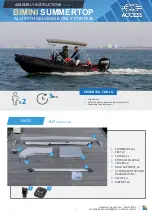
Physical/remote access
• If possible, operate the devices only within a protected network area. Attackers cannot access
internal data from the outside when the internal and the external network are separate from
each other.
• Limit physical access to the device exclusively to trusted personnel.
The memory card or the PLUG (C-PLUG, KEY-PLUG, CLP) contains sensitive data such as
certificates and keys that can be read out and modified. An attacker with control of the
device's removable media could extract critical information such as certificates, keys, etc. or
reprogram the media.
• Lock unused physical ports on the device. Unused ports can be used to gain forbidden access
to the plant.
• We highly recommend that you keep the protection from brute force attacks (BFA) activated
to prevent third parties from gaining access to the device. For more information, see the
configuration manuals, section "Brute Force Prevention".
• If possible, use the VPN functionality to encrypt and authenticate communication for
communication via non-secure networks.
• When you establish a secure connection to a server (for example for an upgrade), make sure
that strong encryption methods and protocols are configured for the server.
• Terminate the management connections (e.g. HTTPS, SSH) properly.
• Make sure that the device has been powered down completely before you decommission it.
For more information, refer to "Decommissioning (Page 3)".
• We recommend formatting a PLUG that is not being used.
Hardware / Software
• Use VLANs whenever possible as protection against denial-of-service (DoS) attacks and
unauthorized access.
• Restrict access to the device by setting firewall rules or rules in an access control list (ACL).
• Selected services are enabled by default in the firmware. It is recommended to enable only
the services that are absolutely necessary for your installation.
For more information on available services, see "List of available services (Page 11)".
• To ensure you are using the most secure encryption methods available, use the latest web
browser version compatible with the product. Also, the latest web browser versions of
Mozilla Firefox, Google Chrome, and Microsoft Edge have 1/n-1 record splitting enabled,
which reduces the risk of attacks such as SSL/TLS Protocol Initialization Vector
Implementation Information Disclosure Vulnerability (for example, BEAST).
• Ensure that the latest firmware version is installed, including all security-related patches.
You can find the latest information on security patches for Siemens products at the Industrial
Security (
https://www.siemens.com/industrialsecurity
) or ProductCERT Security Advisories
https://www.siemens.com/cert/en/cert-security-advisories.htm
) website.
For updates on Siemens product security advisories, subscribe to the RSS feed on the
ProductCERT Security Advisories website or follow @ProductCert on Twitter.
• Enable only those services that are used on the device, including physical ports. Free physical
ports can potentially be used to gain access to the network behind the device.
Security recommendations
SCALANCE M826
Operating Instructions, 10/2022, C79000-G8976-C362-07
13
Summary of Contents for SCALANCE M812
Page 10: ...Safety notices SCALANCE M826 10 Operating Instructions 10 2022 C79000 G8976 C362 07 ...
Page 58: ...Maintenance and cleaning SCALANCE M826 58 Operating Instructions 10 2022 C79000 G8976 C362 07 ...
Page 62: ...Technical specifications SCALANCE M826 62 Operating Instructions 10 2022 C79000 G8976 C362 07 ...














































